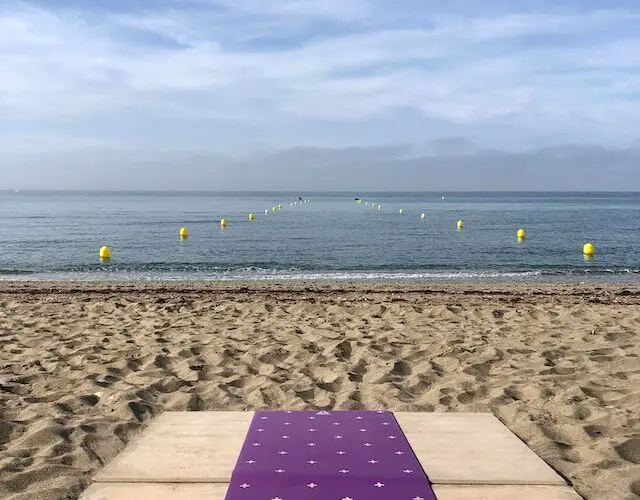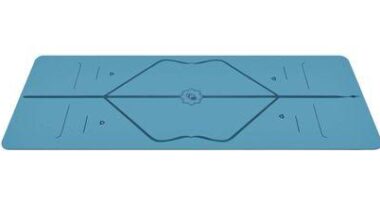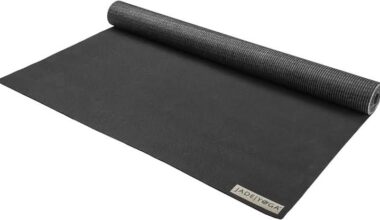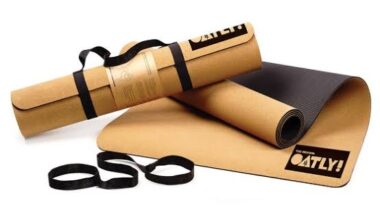Table of Contents Show
Discover the ultimate guide to TPE vs. NBR yoga mats with 5 crucial factors to make your yoga practice shine. Get the scoop on the best choice for your needs!
If you’re into yoga, you know that having the right mat can make a world of difference in your practice. Two popular options in the yoga mat world are TPE (Thermoplastic Elastomer) and NBR (Nitrile Butadiene Rubber) mats. But which one should you choose?
Disclosure: As an Amazon Associate I earn from qualifying purchases.
The Battle of Materials: TPE vs. NBR Yoga Mats
When it comes to yoga mats, the material they’re made of plays a crucial role in your overall yoga experience. TPE and NBR yoga mats are two popular choices, and it’s important to understand the differences between them before making your selection. Let’s dive deep into the world of yoga mat materials and compare TPE vs. NBR to help you find the perfect match for your practice.
The TPE Advantage
TPE yoga mats, short for Thermoplastic Elastomer, have been gaining popularity in the yoga community, and for good reason. These mats are known for their eco-friendliness and non-toxic composition. TPE is a material that combines the benefits of plastic and rubber without the harmful chemicals found in PVC or latex. This eco-conscious choice is not only gentle on the environment but also safe for your health.
The NBR Champion
On the other side of the mat spectrum, we have NBR yoga mats, made from Nitrile Butadiene Rubber. If you’re in search of a yoga mat that provides exceptional cushioning and support, NBR is the material of choice. It’s known for its remarkable ability to protect your joints during challenging poses. NBR mats are durable, resistant to wear and tear, and often preferred by those who need extra comfort and support.
Now, let’s dig deeper into the comparison between TPE and NBR yoga mats.
Material Matters: TPE vs. NBR Yoga Mat Composition
Understanding the materials that makeup TPE and NBR yoga mats is essential in making an informed decision for your yoga practice. The composition of these mats not only affects their performance but also their impact on the environment.
TPE Yoga Mat Composition
TPE yoga mats are composed of a unique blend of thermoplastic and elastomer materials. This combination creates a mat that’s soft, lightweight, and eco-friendly. The absence of PVC and latex in TPE mats makes them a safe and non-toxic choice for yoga enthusiasts. If you’re passionate about both your practice and the planet, TPE is a material that aligns with your values.
NBR Yoga Mat Composition
NBR yoga mats, on the other hand, are crafted from Nitrile Butadiene Rubber, a synthetic rubber compound. This material is highly regarded for its ability to provide excellent cushioning and support. NBR mats are known for their durability and resistance to wear and tear, making them a long-lasting choice for those who demand reliable performance from their yoga mat.
Understanding the composition of TPE and NBR mats is just the beginning.
Durability of TPE vs. NBR Yoga Mats
When it comes to selecting the right yoga mat, one crucial factor to consider is durability. After all, you want a mat that will withstand the test of time and provide a stable surface for your practice. Let’s dive into the durability of TPE and NBR yoga mats and how they compare.
The Durability of TPE Yoga Mats
TPE yoga mats are known for their unique blend of plastic and rubber, offering a soft and comfortable surface for your yoga practice. However, when it comes to durability, TPE mats may have a few considerations to keep in mind.
TPE mats tend to be less dense than NBR mats, which means they may be more prone to wear and tear over time, especially with frequent and rigorous use. They can develop visible signs of wear, like small cracks or indentations, after extended use. This doesn’t mean they lack durability entirely, but if you’re a seasoned yogi who practices daily or participates in intense sessions, you may find that TPE mats wear out more quickly compared to NBR mats.
The Durability of NBR Yoga Mats
NBR yoga mats, made from synthetic rubber, are known for their exceptional durability. These mats are designed to endure the demands of regular use and maintain their quality over an extended period. NBR mats have a higher density compared to TPE mats, making them more resistant to wear and tear.
If you’re someone who practices yoga regularly or enjoys high-intensity sessions, the NBR yoga mat may be your ideal choice. Its durability ensures that it will remain in excellent condition even after countless yoga sessions and various poses.
So, when considering the durability aspect in the TPE vs. NBR yoga mat debate, it’s essential to think about your specific yoga routine and how frequently you plan to use your mat. If you’re looking for a long-lasting option that can handle rigorous use, NBR mats are likely the better choice. However, if you’re a casual yogi or prioritize other factors like eco-friendliness, TPE mats may still be a suitable option.
Eco-friendliness: TPE vs. NBR Yoga Mats
In an era where environmental consciousness is on the rise, choosing eco-friendly yoga equipment is becoming increasingly important. Both TPE and NBR yoga mats claim certain eco-friendly features, but let’s explore the nuances and distinctions between these two materials in terms of their impact on the environment.
The Eco-friendliness of TPE Yoga Mats
TPE (Thermoplastic Elastomer) yoga mats are often touted as the more environmentally friendly option in the TPE vs. NBR yoga mat debate. This is primarily due to their composition, as TPE mats are typically free from harmful chemicals like PVC and latex, making them a safer choice for both users and the environment.
Furthermore, TPE mats are often recyclable, which means that they can be repurposed into other products once their yoga mat life has come to an end. This feature aligns well with the growing demand for sustainable and recyclable products in the yoga community.
The Eco-friendliness of NBR Yoga Mats
NBR (Nitrile Butadiene Rubber) yoga mats, while offering numerous advantages, might not be as eco-friendly as TPE mats. NBR mats are made from synthetic rubber, which may contain synthetic compounds that are less biodegradable compared to TPE.
Additionally, the production process of NBR mats may involve more resource-intensive methods. This could lead to a higher carbon footprint compared to the manufacturing of TPE mats.
In the eco-friendliness comparison, TPE mats seem to have the edge over NBR mats. If you’re passionate about sustainability and want a yoga mat that aligns with your green values, TPE mats are the more eco-conscious choice.
TPE vs. NBR Yoga Mat: Price Battle
When it comes to choosing the perfect yoga mat, cost is a factor that can’t be ignored. Let’s dive into the price battle between TPE and NBR yoga mats and see which one offers the best value for your money.
TPE Yoga Mats: While TPE mats are known for their eco-friendliness and material composition, they tend to be on the higher end of the price spectrum. This is partly due to the production of TPE material, which can be more costly. However, the investment might be worth it for those looking for a durable and environmentally responsible option. TPE mats are often seen as a long-term investment in both your yoga practice and the planet.
NBR Yoga Mats: On the other hand, NBR mats are known for being budget-friendly. These mats offer excellent cushioning and support without breaking the bank. If you’re just starting your yoga journey or are on a tight budget, NBR mats can be a great choice. They provide a cost-effective solution without compromising on quality.
When making your decision, consider your budget and how much you’re willing to invest in your yoga mat. Keep in mind that while TPE mats may have a higher upfront cost, their durability could potentially save you money in the long run.
You May Also Like: TPE vs PVC Yoga Mat: The Ultimate Showdown for a Long-Lasting Yoga Experience
Environmental Impact: TPE vs. NBR Yoga Mat
As the world becomes increasingly eco-conscious, it’s important to consider the environmental impact of the products we use. In the TPE vs. NBR yoga mat showdown, let’s explore which option aligns better with your environmental values.
TPE Yoga Mats: TPE mats are often hailed as the eco-friendly choice. They are typically manufactured without harmful chemicals like PVC and latex. TPE, as a material, is recyclable, which means it can be repurposed and reused. So, if reducing your carbon footprint is a priority, TPE mats offer a greener alternative.
NBR Yoga Mats: NBR mats are made from synthetic rubber, which may involve the use of chemicals during production. While some NBR mats are manufactured with eco-friendliness in mind, they may not be as environmentally responsible as TPE mats. However, many NBR mats are still free from harmful substances like PVC and latex, making them a safer choice.
In the battle of environmental impact, TPE mats win the round for their overall eco-friendliness. They are a sustainable choice for yogis who want to practice with a clear conscience.
To make an informed decision, consider your environmental values and the sustainability goals that matter to you when choosing between TPE and NBR yoga mats. Your yoga practice can be both mindful and eco-conscious.
Are TPE Mats Worth the Investment?
When considering a yoga mat, cost is often a significant factor. Many yogis wonder if TPE mats are worth the investment. To make an informed decision, let’s delve into the factors that contribute to the value of TPE mats.
TPE Mats: A Sustainable Investment
TPE mats, known for their eco-friendliness, are often considered a sustainable investment. These mats are free from harmful chemicals, making them a healthier choice for both you and the environment. The absence of PVC and latex in TPE mats ensures that you’re practicing on a non-toxic surface.
Durability Matters
One of the key aspects of a worthwhile yoga mat is durability. TPE mats, while eco-friendly, may not be as durable as NBR mats. Over time, they can wear out faster, especially with frequent use. However, if you’re not an advanced practitioner and don’t put heavy wear on your mat, a TPE mat can still last a considerable amount of time.
The Price Point
TPE mats are often considered a premium option due to their eco-friendly credentials. However, this can also mean a higher price tag compared to NBR mats. Whether this is worth it depends on your priorities. If you value sustainability and non-toxic materials, the investment in a TPE mat may align with your values.
In summary, TPE mats can be worth the investment if you prioritize eco-friendliness and non-toxic materials in your yoga practice. However, it’s essential to consider your budget and how frequently you practice, as the durability and price point of TPE mats may impact your decision.
Now, let’s move on to the next headline:
NBR Mats: Affordability and Performance
NBR mats have gained popularity among yogis for their affordability and excellent performance. Let’s take a closer look at what makes NBR mats a practical choice.
Affordable Yet High-Quality
One of the standout features of NBR mats is their affordability. These mats are budget-friendly and offer good value for your money. If you’re just starting your yoga journey or don’t want to invest heavily in a yoga mat, NBR mats are an attractive option.
Superior Cushioning and Support
NBR mats excel in cushioning and support. If you have joint issues or need extra padding during your practice, these mats can be your best companion. They provide a comfortable surface that absorbs the impact and supports your body, making them ideal for individuals who need extra care during their yoga sessions.
Longevity and Durability
NBR mats are known for their longevity and durability. They can withstand regular use and maintain their shape and quality for an extended period. This means your investment in an NBR mat is likely to pay off in the long run, making it a cost-effective choice.
Conclusion
In the TPE vs. NBR yoga mat showdown, the right choice ultimately depends on your personal preferences and needs. Both mat types have their unique advantages and considerations, and here’s how to make the best decision:
If you’re looking for an environmentally friendly option and are willing to invest a bit more, the TPE yoga mat might be your go-to choice. It’s free from harmful chemicals like PVC and latex and offers a lightweight, easy-to-carry design.
On the other hand, if you require extra cushioning and support during your yoga practice, the NBR yoga mat is your best bet. It’s known for its durability, excellent cushioning, and budget-friendly price tag.
Remember that the best yoga mat for you is the one that suits your specific needs and aligns with your values. Make sure to consider factors such as cushioning, eco-friendliness, and price when making your decision.
FAQs
Q1. Are TPE mats non-toxic?
A: Yes, TPE mats are typically non-toxic and considered a safe choice for yoga practitioners. They are free from harmful chemicals like PVC and latex, making them an excellent option for those with sensitivities.
Q2. Which mat is better for beginners?
A: NBR mats are often recommended for beginners, especially if you’re seeking a softer, more cushioned surface that’s gentle on your joints. The added support can make your initial yoga experiences more comfortable.
Q3. Can I use a TPE mat for hot yoga?
A: Yes, TPE mats are suitable for hot yoga sessions. They offer good grip and are easy to clean, making them a practical choice for this sweat-inducing practice.
Q4. Do NBR mats have a strong rubber smell?
A: Some NBR mats may have a noticeable rubber smell when they are brand new. However, this scent typically diminishes with time and use. If the odor is a concern, consider airing out your mat before using it.
Q5. Which mat is more environmentally friendly?
A: TPE mats are generally considered more environmentally friendly due to their composition. They are often made with recyclable and biodegradable materials, aligning with eco-conscious yogis’ values.




